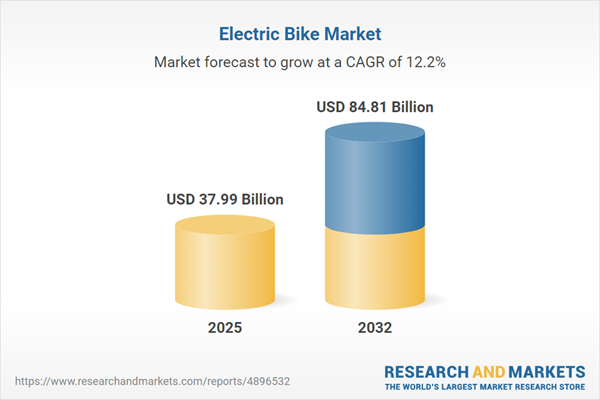Speak directly to the analyst to clarify any post sales queries you may have.
The electric bike market is experiencing significant transformation as innovative technologies, consumer demand shifts, and environmental regulations collectively accelerate adoption and redefine urban mobility.
Market Snapshot: Electric Bike Market Growth and Outlook
The electric bike market expanded from USD 33.82 billion in 2024 to USD 37.99 billion in 2025 and is projected to reach USD 84.81 billion by 2032, registering a CAGR of 12.17%. This impressive trajectory underscores robust and sustained demand across commercial, commuting, logistics, and recreation segments as well as increasing adoption by both organizations and individuals.
Scope & Segmentation
This report explores the comprehensive landscape of the electric bike sector across key market segments, geographic regions, and technological categories:
- Product Types: Cargo (Front Cargo, Rear Cargo), Commuter (City, Hybrid, Touring), Fat Tire (Off Road, Recreational), Folding (Compact, Full Size), Mountain (Cross Country, Downhill, Enduro, Trail)
- Battery Types: Lead Acid, Lithium Ion, Nickel Metal Hydride
- Drive Systems: Hub Motor (Direct Drive, Geared Hub), Mid Drive Motor
- Power Output Ranges: 250-499W, 500-999W, Above 1000W, Below 250W
- Speed Types: Pedelec, S-Pedelec
- Application Areas: Commercial (Delivery, Rentals), Personal, Recreation, Sports
- Sales Channels: Offline (Bike Shop, Specialty Store, Supermarket), Online (Company Owned, Third-Party Marketplace)
- Price Ranges: High End, Low End, Mid Range, Premium
- Regional Coverage: Americas (North America: United States, Canada, Mexico; Latin America: Brazil, Argentina, Chile, Colombia, Peru), Europe, Middle East & Africa (Europe: United Kingdom, Germany, France, Russia, Italy, Spain, Netherlands, Sweden, Poland, Switzerland; Middle East: United Arab Emirates, Saudi Arabia, Qatar, Turkey, Israel; Africa: South Africa, Nigeria, Egypt, Kenya), Asia-Pacific (China, India, Japan, Australia, South Korea, Indonesia, Thailand, Malaysia, Singapore, Taiwan)
- Leading Companies Analyzed: Accell Group N.V., Addmotor Tech., AIMA Technology Group Co., Ltd., AmericanElectric, Ampler Bikes OÜ, Ariel Rider Ebikes, Aventon, Beistegui Hermanos S.A., Brompton Bicycle Limited, Cowboy SA, ENERMAX Technology Corporation, Giant Manufacturing Co., Ltd.
Key Takeaways for Senior Decision-Makers
- Government policies, including subsidies and infrastructure investment, are propelling electric bike market adoption and shaping regional competitive advantages.
- Technological advances in battery chemistry and motor design enable enhanced range, efficiency, and integration of connectivity solutions, supporting value-added and service-driven business models.
- Consumer preferences increasingly favor sustainable transportation and flexible urban mobility, driving momentum for e-bikes across both commercial logistics and personal commuting applications.
- Market participants are establishing regional manufacturing alliances and diversification strategies to manage risks associated with tariffs and supply chain disruptions.
- Segmentation across product types, battery technologies, and price ranges allows precise targeting of end-users, optimizing channel and product strategies within diverse regulatory markets.
Tariff Impact: 2025 Policy and Supply Chain Considerations
Recent U.S. tariff policies have prompted shifts in sourcing and assembly strategies. Duties on imported electric bike components are fueling cost increases and encouraging domestic production alliances. In response, many original equipment manufacturers are optimizing their supply chains through regional partnerships, local assembly, and exploration of alternative materials to reduce dependency on tariffed parts. Competitive dynamics are further shaped by domestic joint ventures and innovative approaches to cost management and value preservation.
Methodology & Data Sources
This market analysis is grounded in a rigorous combination of primary research methods—executive interviews, expert panels, and stakeholder focus groups—and secondary research from corporate filings, industry reports, patent databases, and trade association data. Insights were validated using cross-comparison, scenario analysis, and benchmarking to ensure reliability and actionable depth.
Why This Report Matters
- Pinpoints high-growth opportunities and evolving market trends informed by thorough electric bike market analysis.
- Delivers clarity on regional differences and strategic routes for mitigating regulatory and geopolitical risks.
- Guides OEMs, investors, and partners in formulating effective product, supply chain, and channel strategies aligned with market and technology shifts.
Conclusion
This electric bike market research provides essential insights into market trends, regulatory impacts, and segmentation strategies, empowering senior stakeholders to drive sustained growth and informed investment in this rapidly evolving sector.
Additional Product Information:
- Purchase of this report includes 1 year online access with quarterly updates.
- This report can be updated on request. Please contact our Customer Experience team using the Ask a Question widget on our website.
Table of Contents
3. Executive Summary
4. Market Overview
7. Cumulative Impact of Artificial Intelligence 2025
Companies Mentioned
The companies profiled in this Electric Bike market report include:- Accell Group N.V.
- Addmotor Tech.
- AIMA Technology Group Co., Ltd.
- AmericanElectric
- Ampler Bikes OÜ
- Ariel Rider Ebikes
- Aventon
- Beistegui Hermanos S.A.
- Brompton Bicycle Limited
- Cowboy SA
- ENERMAX Technology Corporation
- Giant Manufacturing Co., Ltd.
Table Information
| Report Attribute | Details |
|---|---|
| No. of Pages | 195 |
| Published | November 2025 |
| Forecast Period | 2025 - 2032 |
| Estimated Market Value ( USD | $ 37.99 Billion |
| Forecasted Market Value ( USD | $ 84.81 Billion |
| Compound Annual Growth Rate | 12.1% |
| Regions Covered | Global |
| No. of Companies Mentioned | 13 |









